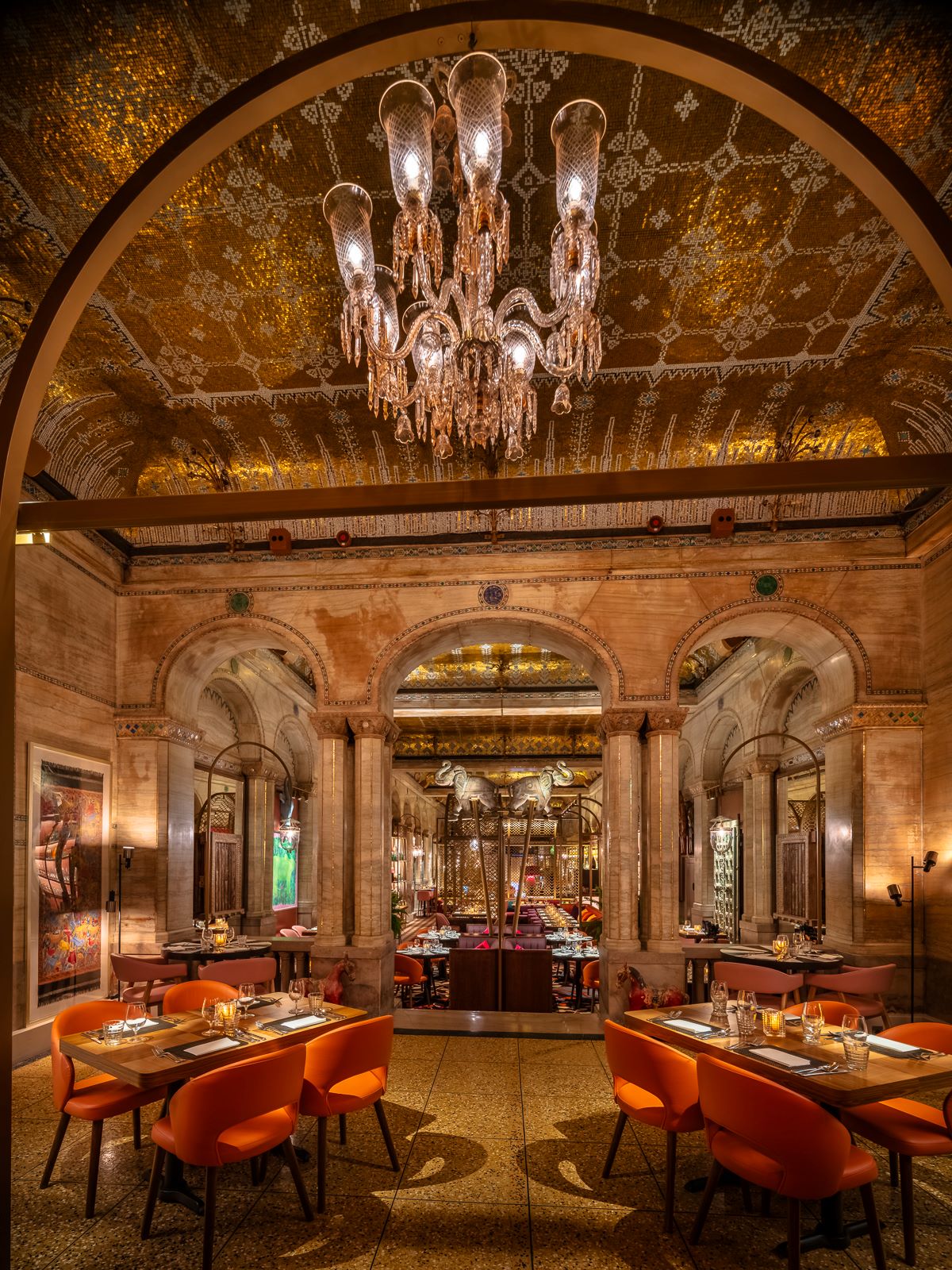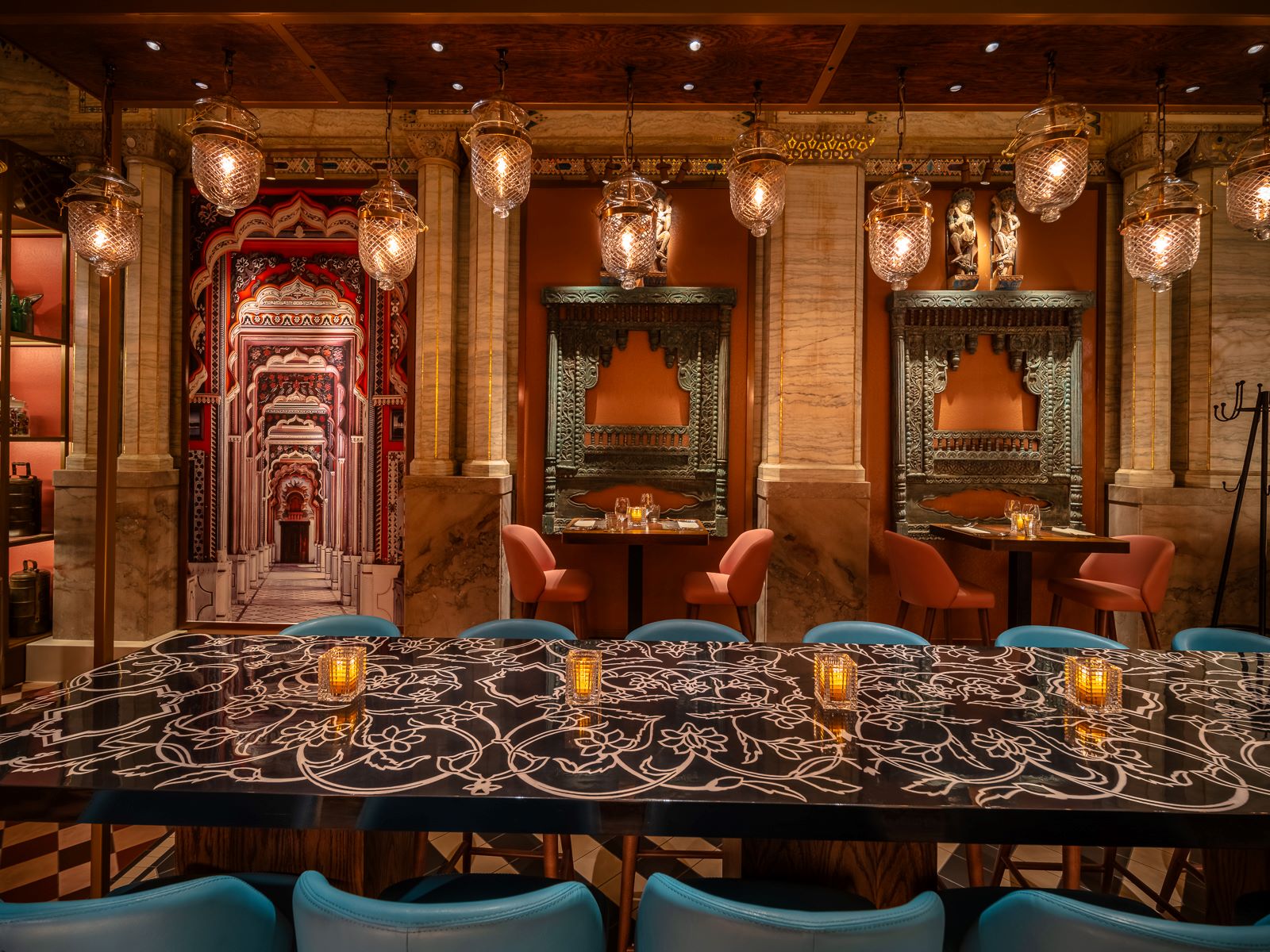Masala Zone Piccadilly Circus
Whilst looking at the images below of the new Masala Zone restaurant in London’s Piccadilly bear in mind that the interior is Grade II star listed.
This means that during the refurbishment process the original, and beautiful, gold mosaic ceiling, marbled walls and columns had to remain untouched.
Everything within this design has been meticulously hung using platforms and installations, including the lighting fixtures and artworks.
Nothing is attached to the existing structure – everything ‘floats’ in the space and yet the result is striking: as if the ceiling, walls, furniture and fittings were all designed in tandem.
New and old meld into one magnificent and playful design.

Over the past few decades this space, formerly known as the Criterion restaurant, has been reinvented, redesigned and run by various operators, including Marco Pierre White, but the interiors have never looked so lavish.
Like all Masala Zone restaurants there is a story behind the design.
Here we imagine a Maharaja’s dining room has been transformed into a grand brasserie.
The interior designer, Malasia-based Canadian, Jeffrey Wilkes, has worked with the Masala Zone founders, Ranjit Mathrani, Namita Panjabi and Camellia Panjabi on various projects over the past 20 years and they have developed a unique understanding in terms of their objectives.

Visual Idioms
The key design objective here was to create interiors which could match and complement the palatial ceilings and marble walls using a wide array of Indian visual idioms combined with contemporary design.
Further, the design should create an intimate sense of place and atmosphere within what is a truly vast and cavernous interior (300 square metre ground floor restaurant space with a seven metre high ceiling).
Jali-inspired screens direct the space, creating different levels of intimacy, whilst allowing a discerning eye to penetrate the view – like a Maharaja watching over diners below in the Palace.
Crisp oak and multi-hued tweed banquettes fuse a contemporary London club with an energetic Rajasthan Market.
The luminous bar glows a stunning pink – a 21st century graphically enhanced take on an enormous piece of crystal.

“The respectful layering of history into a colourful, joyful and exuberant interior provides a comfortable, warm cocoon to dine on inspired Indian cuisine.”
Jeffrey Wilkes.

Bold Colour
With a bold use of colour and pattern, heavily inspired by Camellia Panjabi’s beautiful Indian kaftans, Jeffrey Wilkes has taken textiles, elements and surfaces and beautifully layered them around the site.
Marble arched walls with inlays of turquoise and azure, rose, clay, malachite and gold complement the iconic gold mosaic ceiling.
Pockets of pattern consume the venue – from the bespoke Mughal-inspired floral carpet, a powerful, eye-catching design full of bold colours to a mix of tabletops, timber, inlay and stone, adorned in a variety of lavish and dramatic designs.

Over several years, Wilkes, Mathrani and the Panjabi sisters, have accumulated meaningful artefacts, murals, and paintings on their travels across India – these are showcased amongst light-refracting-coloured panels or amongst shelves.
There are dozens of brass tiffins, once used on the trains, antique soda bottles, and jars filled with tops and toys.
A striking focal point in the centre of the restaurant are the two large elephants, elevated on brass posts, which add a layer amongst the various seating and table-top heights, breaking down the formality.


The end wall of the restaurant is dominated by a three-metre painting by Udaipur artist, Shahid Parvez, of the Maharaja and Maharani themselves enjoying the room, dancing and dining with their pet Blue Leopard.

Jeffrey Wilkes is the creative force behind global projects including Mandarin Oriental Hotels in Bangkok and Jumeirah Dubai as well as Oberoi, Taj, Leela and ITC Hotels in India.
He is recognised by Forbes Travel Guide and is on the Conde Nast Traveller’s Gold List.
Masala Zone Piccadilly Circus is the seventh restaurant from MW Eat (which is co-owned by Ranjit Mathrani and Namita Panjabi).
The group is renowned for its subtle spicing and profound flavours and for bringing the very best of proper Indian food from ‘the gourmet to the everyday’ in London since 1990.
Ranjit, Namita and Camellia Panjabi are behind the highly acclaimed Chutney Mary, London’s first Indian fine-dining restaurant, Michelin-starred Amaya; the restaurant that introduced culinary drama with the first open kitchen, and Michelin-starred Veeraswamy, the UK’s oldest Indian restaurant.





